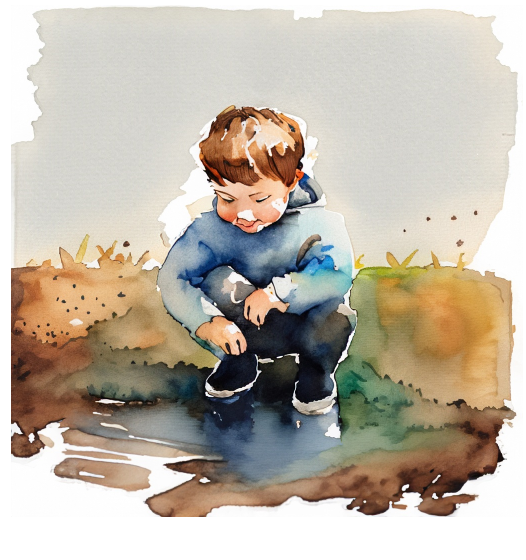Back when I had a long commute, I heard a podcast guest make a reference in passing to Lao Tsu’s principle of letting the dirt settle in your mud puddle.” Although it was quite relevant to the topic of the episode, neither the guest nor the host said anything more about it, leaving me to explore it on my own. The podcast episode topic dealt with handling chaos in our lives, and more than once I have struggled with feelings of overwhelm and chaos. I made a quick voice note about it, transcribed it during my weekend processing day, and forgot about it—until I was strolling through my blog ideas and found it again. I still don’t know much about Lao Tsu, but this effort was definitely worthwhile.
Lao Tsu, the ancient Chinese philosopher and founder of Taoism, left behind a wealth of wisdom in his classic work, the Tao Te Ching. (I’ve added this to my reading list.) Among his profound teachings is the enigmatic phrase, “letting the dirt settle in your mud puddle.” While the exact origin of this expression may be unclear, we can draw inspiration from Lao Tsu’s broader philosophy to derive meaningful insights. I’ve developed three main points inspired by this phrase, highlighting its relevance in my quest for clarity and understanding.
Point 1: Cultivating Stillness and Patience
In a world bustling with constant activity and distractions, Lao Tsu encourages us to find solace in stillness. When we let the dirt settle in a mud puddle, we allow time and space for the sediment to gradually sink, revealing clarity underneath. Similarly, by cultivating inner stillness and exercising patience, we create an environment that allows our thoughts, emotions, and experiences to settle. Through this practice, we can gain a deeper understanding of ourselves and the world around us.
My application of it:
If you know anything about me, you know I love technology, and I’m often found to be engaging with tech in some way. However, I must decompress in order for my technology to be useful. There’s just too much information available. Much like Dumbledore’s Penseive, by disconnecting from the information sources, and even by letting go of the effort to make sense of all of it, I can let my thoughts and ideas settle into their own natural places, and when my mind is calm and composed, I can look through the sediment and find patterns and links, and make sense of all of it.
Point 2: Allowing Natural Order to Unfold
Lao Tsu often emphasized the importance of harmonizing with the natural order of things, known as the Tao. By letting the dirt settle in our metaphorical mud puddles, we align ourselves with the natural flow of life. Instead of attempting to force solutions or control outcomes, we learn to surrender to the unfolding of events. This acceptance allows us to observe and discern the truth that emerges organically, free from our biases and preconceptions. By trusting in the inherent wisdom of the universe, we find clarity in embracing what is, rather than imposing our own desires.
My application of it:
In my eternal perspective, our lives are busy and hectic, often impeding the efforts of the Holy Ghost to whisper to us. It can become difficult to discern the efforts of Satan to deceive us, because he throws a lot at us at once. We’re occupied in dodging stones and arrows while trying to pull good words and deeds from the world around us. Sometimes we just need to step away from the chaos, even just a few steps to a quiet room or a porch swing, to not think, to just listen. To breathe deeply. To not be the one solving the problems of the world. The problems can wait a few minutes or someone else can solve them while I just go somewhere and be.
Point 3: Embracing the Power of Non-Action
The concept of non-action, or wu-wei, is central to Lao Tsu’s philosophy. It does not imply complete inaction but rather aligning our actions with the natural rhythm of existence. When we let the dirt settle, we refrain from impulsively reacting or making hasty judgments. Instead, we engage in contemplation, reflection, and self-awareness. By practicing non-action, we become attuned to the subtle currents of life, discerning the appropriate moments to act and when it is best to abstain. This deliberate approach leads to greater clarity and allows us to respond to situations from a place of wisdom.
My application of it:
Deciding not to act is a decision to act. Consciously taken, it can be a wise choice. It’s very different from defaulting to not act due to fear or overwhelm. Sometimes the correct action is to let things evolve on their own. The option of not acting is best facilitated when we have made the effort to understand what our available choices are and the consequences of each of them. Doing nothing isn’t always the best option, but sometimes it will be.
It’s Your Puddle
Lao Tsu’s phrase, “letting the dirt settle in your mud puddle,” encapsulates timeless wisdom that resonates with our quest for clarity and understanding. By embracing stillness, allowing the natural order to unfold, and harnessing the power of non-action, we cultivate an environment that nurtures insight and truth. It’s your puddle. You can often find out what’s in it by following Lao Tsu’s teachings and finding solace in the depths of our own metaphorical mud puddles, patiently awaiting the settling of the dirt to reveal the clarity that lies beneath.








